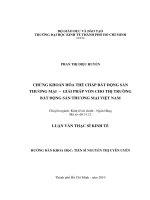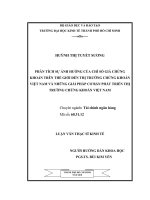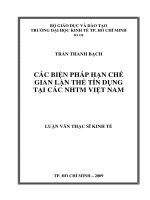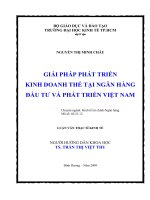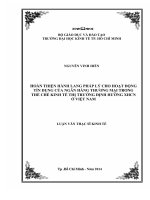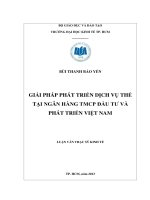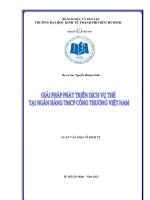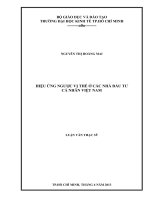The impact of borrowers attributes on the possibility of SMEs loan approval in HCMC, viet nam luận văn thạc sĩ
Bạn đang xem bản rút gọn của tài liệu. Xem và tải ngay bản đầy đủ của tài liệu tại đây (554.4 KB, 83 trang )
UNIVERSITY OF ECONOMICS HO CHI MINH CITY
International School of Business
----------------------------
PHAN THI TRAN NGA
THE IMPACT OF BORROWERS’
ATTRIBUTES ON THE POSSIBILITY OF
SMEs LOAN APPROVAL IN HCMC, VN
MASTER’S THESIS
SUPERVISOR: Dr. CAO HAO THI
Ho Chi Minh City, 2013
i
ACKNOWLEDGEMENTS
Firstly, I would like to express my gratitude to Dr. Cao Hao Thi, my supervisor
who has given a zealous support and advices during doing research period.
Especially, I am grateful for his enthusiasm in answering, reminding as well as his
feedback, guidance and correction for me able to accomplish this thesis.
Secondly, I would like to thank Dr. Dinh Thai Hoang who taught data analysis,
helped me analysis methodology and data process of this thesis as well.
Thirdly, I would also like to thank all of my lecturers at International School of
Business (ISB) – University of Economics Ho Chi Minh City (UEH) – for
exchanging & sharing their knowledge and experience during my master course.
Enthusiastic assistance provided by the ISB’s executive board and staffs was also
greatly appreciated.
Next, I would like to say thank you for creditors, who helped me to conduct
survey, gave suggestions and shared their experience in profession to do this
research better.
Last, I would also want to thank my friends and classmates who share their
knowledge support, and work with me during time I do this study.
ii
ABSTRACT
Small and medium sized Enterprises (SMEs) play an important role in transitional
economies and have high relevance for their economic policy of many countries.
In Vietnam, SMEs account for 77 percent and 87 percent by regular workforce and
registered capital criteria in 2011 (Cuong, Sang & Anh, 2008) and produce over
40% of GDP. Yet, the SMEs have some difficulties in lacking of finance supply
from financial institutes or banks. So this research will identify the factors
effecting to the loan decision-making. From those factors, researcher will find
down the key one that impacts strongest on the possibility of loan approval.
Before a bank decides to invest into companies in a form of loan, they will put into
consideration a lot of aspects. In this decision making process, bank officers will
take into account a lot of different kind of borrower’s attributes related to
background and experience, the business and conditions surrounding it.
This research is done by thorough literature review on concepts relating to six
borrower’s attributes. The analyzing result found there are only three among six
borrower’s attributes which have positively related to possibility of SMEs loan
approval. The research model explained 47.3% the variance of the borrower’s
attributes on the possibility of SMEs loan approval.
Key words: SMEs, loan approval, relationships with the bank, value of collateral,
firm size, related business experience, share of investment, business plan
iii
TABLE CONTENT
ACKNOWLEDGEMENTS.................................................................................... i
ABSTRACT
.................................................................................................. ii
ABBREVIATION ................................................................................................. v
LIST OF TABLES ............................................................................................... vi
LIST OF FIGURES............................................................................................. vii
CHAPTER 1
INTRODUCTION ................................................................... 1
1.1.
Research background ............................................................................... 1
1.2.
Research Problem .................................................................................... 3
1.3.
Research objectives .................................................................................. 5
1.4.
Research scope ......................................................................................... 5
1.5.
Research contribution ............................................................................... 5
1.6.
Research structure .................................................................................... 6
CHAPTER 2
LITERATURE REVIEW ........................................................ 7
2.1.
Approval loan ......................................................................................... 7
2.2.
Borrower's Attributes ............................................................................... 9
2.2.1.
Relationship with the bank................................................................. 9
2.2.2.
Firm size.......................................................................................... 11
2.2.3.
Value of collateral ........................................................................... 12
2.2.4.
Related business experience............................................................. 13
2.2.5.
Share of investment ......................................................................... 14
2.2.6.
Business plan ................................................................................... 15
2.3.
Lender’s human capital .......................................................................... 17
2.3.1.
Education ........................................................................................ 18
2.3.2.
Lending experience.......................................................................... 19
2.4.
Research model ...................................................................................... 19
2.5.
Hypotheses of this study......................................................................... 20
CHAPTER 3
3.1.
RESEARCH METHODOLOGY .......................................... 22
Research process ................................................................................... 22
iv
3.2.
Measurement scale ................................................................................. 24
3.3.
Sample size ............................................................................................ 26
3.4.
Methods of data collection ..................................................................... 27
3.5.
Methods of data analysis ........................................................................ 28
3.5.1.
Descriptive statistic.......................................................................... 28
3.5.2.
Testing the reliability ....................................................................... 28
3.5.3.
Exploratory Factor Analysis (EFA) ................................................. 29
3.5.4.
Multiple regression analyses ............................................................ 29
CHAPTER 4
4.1.
DATA ANALYSIS ................................................................. 31
Result of Pilot survey ............................................................................. 31
4.1.1.
Testing the reliability of Relationship with bank and business plan . 31
4.1.2.
Exploratory factor analysis (EFA) ................................................... 33
4.2.
Result of official survey ......................................................................... 34
4.2.1.
Descriptive statistics analysis........................................................... 34
4.2.2.
Refinement of measurement scale.................................................... 37
4.2.3.
Hypotheses testing ........................................................................... 41
CHAPTER 5
CONCLUSION ...................................................................... 50
5.1.
Findings ................................................................................................. 50
5.2.
Managerial implications and recommendation ....................................... 52
5.3.
Research Limitations .............................................................................. 54
5.4.
Suggestions for further research ............................................................. 54
REFERENCES ................................................................................................ XI
APPENDIX A
INTERVIEW QUESTIONS ............................................... XVII
APPENDIX B
QUESTIONNAIRE ............................................................. XIX
APPENDIX C
DISCUSSION FOR EXPLAINATION........................... XXVIII
APPENDIX D
REGRESSION RESULT .................................................. XXIX
v
ABBREVIATION
SMEs: Small and medium enterprises
SPSS: Statistical Package Software for Social Science
EFA:
Exploratory factor analysis
vi
LIST OF TABLES
Table 3.1a
Measurement scale for independent and dependent factors ............. 25
Table 3.1b
Measurement scale for control variables......................................... 26
Table 4.1
Reliability of Relationship with the bank (REL) ............................. 32
Table 4.2
Reliability of Business Plan (PLA) ................................................. 32
Table 4.3
KMO and Bartlett's Test ................................................................. 33
Table 4.4
Total Variance Explained ................................................................ 33
Table 4.5
Rotated Component Matrixa ........................................................... 34
Table 4.6
Descriptive statistics....................................................................... 35
Table 4.7
Reliability of relationship with the bank (REL) .............................. 37
Table 4.8
Reliability of business plan (PLA).................................................. 38
Table 4.9
KMO and Barlett’s Test ................................................................. 38
Table 4.10
Total Variance Explained ............................................................... 39
Table 4.11
Rotated Component Matrixa ........................................................... 40
Table 4.12
Matrix Correlations between variables in equation regression ........ 42
Table 4.13
Model Summaryb ........................................................................... 44
Table 4.14
Regression analysis result .............................................................. 44
Table 4.15
Hypotheses summary ..................................................................... 47
vii
LIST OF FIGURES
Figure 1.1
SMEs’ contribution for economy by country .................................... 2
Figure 2.1
The Research model. ...................................................................... 20
Figure 3.1
Research process ............................................................................ 23
Figure 4.1
The revised research model ............................................................ 48
1
CHAPTER 1
1.1.
INTRODUCTION
Research background
Small and medium sized Enterprises (SMEs) play an important role in transitional
economies and have high relevance for their economic policy of many countries.
Thus, governments throughout the world focus on the development of the SME
sector to promote economic growth (Olawale & Garwe, 2010). In Vietnam,
according to a Spring 2011 report the number of SMEs is nearing 400,000. SMEs
represent 99 percent of the number of businesses of the country and occupy an
overwhelming proportion in total number of country’s enterprises accounting for
77 percent and 87 percent by regular workforce and registered capital criteria in
2011 (Cuong, Sang & Anh, 2008). According to the government over 40% of GDP
is produced by SMEs. From that, SMEs have vital and undeniable roles in
promoting economic and social development in Vietnam. They have made a
significant contribution to the country’s advancement and enhancing the efficiency
and the flexibility of the economy (Cuong, 2007). Apart from being a relatively
dynamic sector in the economy, SMEs have role in creating jobs, maintaining high
mobility of the labor market, and narrowing development gaps among localities of
the country (Cuong, Sang & Anh, 2008).
Despite the positive contribution for economy, SMEs still face the difficulty in
accessing loan. So the financing for small and medium enterprises (SMEs) recently
years has been a subject of great interest both to policymakers and researchers
(Beck, Demirgüç-Kunt, & Pería, 2009). Because financing loan is necessary for
2
enterprises in the economic crisis period. Especially for SMEs, accessing finance
becomes more important because that helps them have capital to continue
operating and developing. However, with limited supply fund from financial
institutions, but increasing financial demand of enterprises, how SMEs do to
access loan that depends on many factors, including the borrower’s attributes and
banks’ side ones. And how the borrower’s attributes affect to the possibility of
SMEs loan decision-making which is the issue needs to research in this paper.
The figure 1.1 illustrates a more in-depth look of the breakdown the small business
impact on the economy by country.
Figure 1.1
SMEs’ contribution for economy by country
Source: SMEs in Asian Report 2011–12; McKinsey Global Institute analysis
3
1.2.
Research Problem
The capacity for SMEs will develop their potential in an economy depends on the
availability of finance. Finance in general and credit in particular is especially
important for all of businesses as well as SMEs, since they are unable to finance
themselves through retained earnings or equity financing. Most SMEs rely on
informal sector financing to meet their needs. The main source of formal financing
is bank lending. Despite the fact that financing is a major factor for growth of
SMEs and the state-owned Commercial Banks (SOCBs) are beginning to extend
more credit to the SMEs, most SMEs still face problems when accessing to bank
finance. And SMEs generally tend to be confronted with higher interest rates, as
well as credit rationing (OECD, 1998).
In Vietnam, according to World Bank’s assessment, one of the biggest
weaknesses in business environment is the problem of access finance (TTVN,
2012).
Besides, as announced by the Vietnam Chamber of Commerce and
Industry (VCCI) on 14 March, 2012, Vietnamese SMEs have difficulties in
accessing loans rather than big enterprises (LD, 2012). Because of unable
accessing finance, many Vietnamese SMEs stop operating temporarily and go
bankruptcy as lack of fund (Chi, 2012).
There are many factors to be considered by a bank before a loan approval is made.
Coleshaw (1989), states if there is a single bad loan, the bank will suffer not only a
financial loss, but also significant damage to its reputation (as cited in Ottavia,
2011). These negative impacts are why, before any decisions are made on loan
4
applications, the credit officers perform extensive analyses to screen out potential
bad loans. In this decision-making process, the bank officers need to consider
different attributes related to the borrower's background and experience, the
business and the conditions surrounding it (Bruns, Holland, Shepherd, & Wiklund,
2008). And these attributes may affect the likelihood of loan approval by credit
institutions in general and in banks in particular.
As mentioned above, finance is an essential element for business maintains and
develops them. Yet, not all enterprises can have enough effort to do with their
internal capital, they often base on external capital that is loan from banks in usual.
However, with the limited fund and in order to avoid the repay risk, banks as well
as creditors have to put into consideration carefully to choose the best firms to
grant loan. Therefore, there will be many SMEs cannot achieve credit that is the
problem need to do in this study.
Furthermore, in Vietnam, there are not many studies which gave explanations on
the relationship between borrower’s attributes, lender’s human capital and
possibility of loan approval. This research is practical significance for accessing
loan and exploring the impact of the borrower’s attributes on the possibility of loan
approval; and how lender’s human capital effect to likelihood of loan approval;
and just focuses on loans to SMEs because they occupy majority among the
number of businesses in Vietnam.
5
1.3.
Research objectives
The objectives of this research are to:
-
Identify borrower’s attributes effect to the possibility of loan approval from
financial institutions as well as banks in Vietnam.
-
Find down the key and decisive attribute affects to the possibility of loan
approval.
-
Recommend for SMEs in Vietnam when applying loan application in order
to receive loan grant.
1.4.
Research scope
The survey will be conducted on commercial Banks including foreign, owned-state
and corporate banks in HCMC, Vietnam. The respondents will be these banks’
creditors who are responsible for collecting and evaluating information regarding
to prospective borrower as well as plays the decisive role in loan approval.
1.5.
Research contribution
The research result will help SMEs in Vietnam focus on three attributes that
strongly impact loan decision are relationship with the bank, related business
experience, and business plan in order to receive the loan grant highly when
applying a loan application. Especially, new enterprises with less related business
experience should consider the factor of relationship with the bank and wellprepare the business plan so that they can achieve loan approval.
6
1.6.
Research structure
This research includes five chapters from chapter 1 to chapter 5. The first chapter
or introduction generally introduces the research background, research problems,
research objectives, research scope, and research contribution.
Chapter 2 is called literature review. In this part, it presents concepts and theories
relating to loan approval (5Cs principal), borrower’s attributes and lender’s human
capital affect to loan decision-making in previous studies. Based on theories, initial
research model and hypotheses used for the research are formed.
Next, Chapter 3 is research methodology that will show the research process and
data collection. There are 3 elements in Data collection consisting of data sample,
data size and method using in this research.
Then, Chapter 4, data analysis will reports the analysis results of data collected
from the survey.
The last chapter is conclusions, this will summarize the findings; discuss the
managerial implications and recommendation based on the results in chapter four;
and show the research limitation as well as the suggestion for further research.
7
CHAPTER 2
LITERATURE REVIEW
The purpose of this chapter is an overview of relevant literature affecting to the
loan making-decision. These include the approval loan and borrower’s attributes
which have been conducted by previous researches. Based on these studies,
conceptual model is proposed.
2.1.
Approval loan
In the banking industry, the credit department is the largest income source for
banks (Ottavia, 2011). This income, in the form of loan interest and provision,
makes up a significant percentage of a bank's assets (Golin, 2001). Therefore, loan
quality is an important criterion in establishing the creditworthiness of a bank
(Golin, 2001). It is a guarantee to ensure that the loans released will continue to
work and to generate profit for the bank (Booth, J. R. & Booth, L. C., 2006;
Rosman & Bedard, 1999). Loans are given based on the belief that the borrower
can be trusted to repay the debt (Golin, 2001). Before granting the loan, the
creditor will consider the nature of business, how it run, the micro and macro
economics as well as collateral assured by borrowers (Ottavia, 2011). In the
banking industry, the loan evaluation process has been standardized for the sake of
systematic evaluation. The traditional practice which banks apply to process and
estimate loan is 5Cs principle.
The first C is Capacity that reflects the borrower's financial condition (cash flow &
payback period of project), future prospects, firm ability and management
experience (Riding, Haines & Thomas, 1994). After analyzing this feature, the
8
creditor will give conclusion to decide whether business’ cash flow has enough to
repay the loan or not (Golin, 2001; Sauder and Allen, 2002).
The second C stands for Capital which corresponds to the equity or owner’s share
to business’ assets (Golin, 2001); Money contributed to support the firm's
operation, and the firm's survival prospects (Barret, 1990).
The third C represents Collateral. It is any form of asset pledged as a guarantee in
exchange for the loan from the bank by firm. Or it can be in a form of guarantee
from the third party. This assets or guarantee are used to assure loan in case the
risk loan and the business cannot repay to the banks (Golin, 2001).
The fourth C is Character that relates to the borrower's reputation, age, gender, risk
profile, business experience and apparent quality, integrity, stability and
willingness to repay the loan (Golin, 2001; Riding, Haines, & Thomas, 1994;
Saunders & Allen, 2002). The character is intangible quality which is as important
as financial information (Barrett, 1990).
The last C is abbreviation of Conditions, they mention to both the macro and
micro economic conditions surrounding the firm's business operation. All
economic condition such as recession, growth, interest, and so on, which can affect
to business as well as the ability to repay loan (Riding, Haines, & Thomas, 1994).
All loan applications are applied to the banks will be screened comprehensive and
careful analyses using the 5Cs as the principle of loan decision-making (Riding,
9
Haines, & Thomas, 1994). The 5Cs principle provides a framework of loan
evaluation for loan officers.
2.2.
Borrower's Attributes
Because there are many borrower’s attributes to be concerned in loan decision
process, this research will just focus on six factors; in which, the first five will
represent for five Cs in principle of credit and one is business plan that is
suggested to add in this research by many bank’s creditors through the interview
before designing first draft questionnaire.
The first five attributes include: Relationship with the bank is replaced for the fifth
C, condition; Firm size is modified by the first C, Capacity; Value of collateral is
very the third C, Collateral; Related business experience is derived from the fourth
C, Character; And the last one, share of investment is very the second C, capital.
2.2.1. Relationship with the bank
Firstly, coming to the relationship with bank, that refers to a lender’s role in
gathering information about the firm through the provision of banking service and
then using the information to decide whether to lend that firm (Dolan, Brouard &
Riding, 2011). Addition, according to Berger & Udell (1998), the most important
feature of SMEs financing is the relative information opacity of the former and
relationship between lender and borrower can help overcome opacity.
According to Rajan (1992), banks that maintain more information about the
borrower will be easy to control the credit expense for profitable projects. By
10
doing this, it will push the borrower to put in pay attention. And the more
information banks have, the more exact the analysis is that they can reduce higher
risk (Rajan, 1992). The respective literature measures the intensity of the
relationship by the duration of relationship. And the duration is expected to affect
to information of the bank stock. In particular, the studies about credit availability
effects of relationship banking, which include Petersen and Rajan (1994), Cole
(1998), and Chakravarty and Yilmazer (2009) use the length of interaction
between borrower and lender in order to measure the strength of a relationship, but
report mixed results. The theoretical research on bank-borrower relationship
provides opposing views on how the length of relationship should affect loan
decision-making.
Thus, the relationship is also measured by trust which may generate from positive
experience in the past (Lehmann & Neuberger, 2001). The nature of the
relationship will also influence the quantity and quality of information available to
the bank. With close relationship, the bank understands the operating environment
of a particular business. Furthermore, relationship provides the basis for
understanding customer need and resource. Besides, the information also implies
that both parties will have a better understanding of each other (Lehmann &
Neuberger, 2001). In order to proxy mutual trust in the bank-borrower relationship,
Lehmann & Neuberger (2001) have introduced the variables relating to experience
in the past, the obligation to partner, the impression of the stability of the
relationship and the flow of information. And also according to these researchers,
the bank can only meet customers need if the firm manager provides appropriate
11
and timely information. This cooperation results in stable relationship, in which
the partners feel obliged to each other. While past experience may reflect the
reciprocity relationship (Blois, 1999), and Fisman and Khanna (1999), have
suggested obligation to the partner may be based on trust that will create stable
relationship. And the stability of relationship depends on consistent behavior, the
sense of deterrence-base trust (Lehmann & Neuberger, 2001).
Therefore, it can be concluded that the firm with a stronger relationship with the
bank lowers the loan officers' screening level, and accesses loan easier. Then, the
following hypothesis is proposed:
H1: A relationship with the bank is positively related to the possibility of loan
approval.
2.2.2. Firm size
Firm size is related to the business scale and the business scope. Both represent the
organisational capital that offers survival benefits (Bercovitz & Mitchell, 2007). A
study by Mitchell (1994) has proved that larger firms and businesses tend to
survive longer than smaller companies. In Vietnam, when mentioning about firm
size, people think about total asset or the number of employees. Size, however in
this research as the previous study, is related to sales levels, directly affects the
profitability and the sustainability of the business (Bercovitz & Mitchell, 2007;
Silverman, Nickerson, & Freeman, 1997).
In fact, banks give different treatment based on the size of the companies. Smaller
companies face more difficulties to acquire a loan rather than their larger
12
counterparts for reasons such as a less-comprehensive track record, limited
performance portfolio, or low asset possession (Harhoff & Körting, 1998). Hence,
there is higher likelihood for smaller companies to be rejected when they apply for
a loan. Larger firms are higher sustainable and more likely to survive in the
business, resulting in a lower risk for the bank. In addition, they also have more
bargaining power. Therefore, it is easier for them to obtain loan approval.
H2: Firm size is positively related to the possibility of loan approval.
2.2.3. Value of collateral
The next is value of collateral, collateral is any form of assets assured as a
guarantee in exchange for the loan from the bank. Addition, Ghosh et al state the
value of the collateral offered by a firm also influences the credit ranking behavior
of the bank (cited in Okurut, Olalekan, & Mangadi, 2011). Collateral is considered
as the last resort to recovery of the loan in a risky case such as bankruptcy, where
the bank can sell the collateral to recover a part or total of the loan. Thus, collateral
can be an outstanding value for the bank when assessing the creditworthiness of
the firm (Bester, 1987). Also before, after obtaining the loan and offering the
collateral, borrower applicants wish to fulfill their obligations and repay credit on
time basis in order to avoid losing the collateral.
A study by Menkhoff, Neuberger and Suwanaporn (2006) showed that the banks
use collateral to reduce credit risks. If collateral is mortgaged to the bank, which
will push the borrowers more effort because they have their assets hold by the
bank. It also reduces the moral hazard when banks lend money out (Jiménez &
13
Saurina, 2004). Banks expect higher collateral from borrowers against higher risks.
Collateral is as a safety net may increase the banks' willingness to take risks.
According to Jiménez and Saurina (2004), collateral reduces a bank's risk exposure
and provides it in case of less careful and to take more risks. Collateral can also be
seen as an instrument to ensure good behavior from the borrowers' side (La Porta
et al., 2003). Borrowers are obliged to try their best to perform their business and
repay loans as the bank's regulation or there is a risk that they will lose the asset
once the loans default. A recent case study done in Portugal by Dermine and de
Carvalho (2006) also supports this argument and found a significant positive
relationship between collateral and loan default recovery. It can be concluded that
the higher the value of collateral pledged to cover the loan, the more pressure for
borrowers to perform according to the bank's requirements. Therefore, the
hypothesis is proposed:
H3: The value of collateral is positively related to the possibility of loan approval.
2.2.4. Related business experience
Knowledge is cumulative (Arthur, 1989). From their accumulated knowledge and
experience, entrepreneurs gain their capacity (Minniti & Bygrave, 2001). This will
help them the how to contribute both business survival and growth f(Cooper,
Gimeno-Gascon, & Woo, 1994).
According to Ottavia (2011), businessmen make their decisions based on specific
knowledge about the market (related to technical aspects, products or industry) and
14
general knowledge about business (how to be entrepreneurial). Both of them are
accumulated through experience, learning-by-doing or direct observation (Minniti
& Bygrave, 2001). Whatever they do, they also increase their capabilities and
establish managing and administrative skills. These skills of problem solving are
patterns constructed from experience; the successful solutions of problems
accumulated from problems happened in the past (Nelson & Winter, 1982).
In the case of a default loan, the more experience gained, as reflecting the older
firm age, the higher the probability of the firm recovering from the
default
(Dermine & de Carvalho, 2006). A more experienced firm will be more able to
survive from a default status. Therefore, the firms obtain experience and skills over
time, they will have a greater chance of survival and achieving business success.
Thus, when these firms apply for a loan to the bank, it will create a more favorable
and advantageous condition to be accepted by the bank. Therefore, the following
hypothesis is proposed:
H4: Related business experience is positively related to the possibility of loan
approval.
2.2.5. Share of investment
Share of investment relates to how much capital is invested by the owner towards
the operation of the firm. Financial capital, equity is an important fund for
businesses to operate, against random shocks and make it possible to develop
business. It also contributes to both business survival and growth (Cooper et al.,
15
1994). The more capital is owned by the firms, the higher possibility there is for
the firms to grow.
Financial capital has a high influence on a firm's survival (Bates, 1990). And
insufficient financial fund lead to business failure (Chandler & Hanks, 1998).
Owner's share of investment is one of the major considerations in loan assessment
because it affects the ratio analyses upon which the loan decisions are based
(Vaughn, 1997). If the owner invests more capital into the firm's operation, she
will share more business risk with the lender, leaving banks with relatively lower
risk.
H5: The owner's share of investment is positively related to the possibility of loan
approval.
2.2.6. Business plan
Business plan is an indispensable element for a loan application and decision
process as well. As we know, most potential funders wish to see a business plan as
a first step in deciding whether or not to invest (Mason & Stark 2004). As Barrow
et al. (2001) noted: “Perhaps the most important step in launching any new
venture or expanding an existing one is the construction of a business plan”.
Kuratko and Hodgetts (2001) suggested that the business plan is the minimum
document required by any financial source. The business plan is therefore the first
– and possibly only – substantial contact that a potential funder has with the
entrepreneur (Shepherd and Douglas, 1999). As Barrow et al. (2001) noted that the
business plan is the ticket of admission giving the entrepreneur his first and often
16
only chance to impress prospective sources of finance with the quality of the
proposal.
Besides, the primary concern of the banker is the risk that the loan will not be
repaid. Accordingly, the most interest of a banker is financial situation of a
business that reflects whether the business can repay the debt, and whether assets
are available from either the business or the entrepreneur to secure the loan if
business fails. A business plan that is used to approach a bank for a loan, must
therefore contain sufficient information for a banker to make this assessment and
to indicate how the loan will be repaid in the case the business performs below
expectations (Smith and Smith, 2000). It is normal practice for bankers to compare
the financial information in a business plan against industry averages.
In evaluating the credit worthiness of a customer, the lending officer has to
evaluate the firm’s ability to respond to changing conditions and develop and
implement effective strategies (Berger & Udell, 1998). For this purpose, the
customer’s business plan is as part of the strategic planning. It is an indicator of the
ability of management to communicate the strategy of the firm to external parties.
The firm’s strategy should be clear and consistent in order to persuade external
parties, such as banks, who make commitments to the firm’s future success
(Sargent and Young, 1991). An SME that shows its intentions in a formal plan will
minimize confusion and enable the lending officer to better understand the
business.
17
In this paper, the definition of business planning is based on the theory from prior
researchers. Business planning is defined those efforts by firm founders to gather
information about a business opportunity and to specify how that information will
be used to create a new organization to exploit the opportunity (Castrogiovanni,
1996). Another supposed business planning the processes of gathering and
analyzing information, evaluating required tasks, identifying risks and strategy,
projecting financial developments, and documenting these things in completed
plan (Sexton and Bowman-Upton, 1991). From the theory, it is concluded that
business plan is an important and necessary factor for a loan application and
lending decision process as well.
H6: The business plan is positively related to the possibility of loan approval.
Above are borrower’s attributes that affecting to the possibility of SMEs loan
approval.
2.3.
Lender’s human capital
Besides the borrower’ attributes, the loan decision-making process is also affected
by one of the factors within the bank is human capital (Dimov & Shepherh, 2005)
which includes knowledge, skill, ability, attitude, talent & experience. Coleshaw
(1989) said human judgment plays an important role in loan decision. Human
capital takes an important role in various organisational activities such as decision
making, strategic planning, and product development, forecasting and marketing
(Van Buren, 1999).
